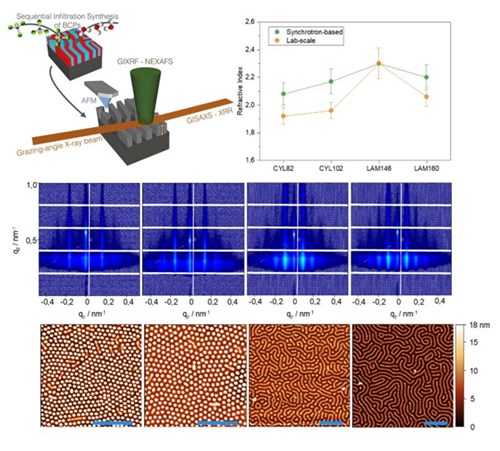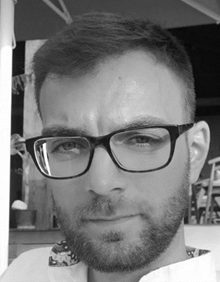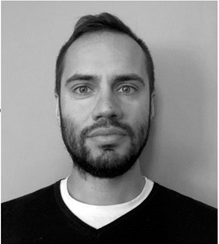Optical properties of self-assembled metasurfaces revealed by novel hybrid-metrology approach

Metasurfaces are artificial materials that can exhibit extraordinary optical properties unattainable in nature, such as a negative refraction index or a broadband enhancement of the emissive properties of single photon sources properly coupled with them. So far, the fabrication of such materials has mostly relied on sequential deposition and growth of metal/metal oxides, or on electrodeposition of metals inside dielectric templates that lead to metasurfaces with an out-of-plane optical axis. However, the in-plane orientation of the optical axis guarantees a more efficient photon extraction decay rate, thanks to better coupling with the guiding modes of nanofibers or waveguides, which is desirable for on-chip integration.
The pursuit of large-scale manufacturing of metasurfaces with customizable functions presents challenges in controlling the dimensions and composition of constituent dielectric materials. To address these challenges, the combination of block copolymer (BCP) self-assembly and sequential infiltration synthesis (SIS) offers an alternative for the fabrication of high-resolution dielectric nanostructures, with tailored composition and optical functionalities.
However, the absence of metrological techniques capable of providing precise and reliable characterization of the refractive index of dielectric nanostructures persists. Precise characterization and a comprehensive understanding of the chemical and physical properties of infiltrated polymeric materials are essential for advancing the sophistication of photonic metamaterials.

GISAXS patterns and AFM micrographs of TiO2 nanostructures with relative refractive indices. Adapted from ACS Appl. Mater. Interfaces 2023, 15, 50, 57992–58002. Copyright (2023) American Chemical Society.
This study introduces a hybrid metrology strategy that integrates complementary synchrotron-based traceable X-ray techniques to achieve comprehensive material characterization for the determination of the effective refractive index at the nanoscale.
“The results we obtained were only possible thanks to the great opportunity to access state-of-the-art facilities at CSIC-IMB (Barcelona) and DESY Synchrotron (Hamburg), which are part of the NFFA-Europe network”, concludes Angelo Angelini.
“Our work is the first to introduce a direct relationship between the material’s properties to the underpinning functionality of metasurfaces with sub-10 nm dimensions”, says Irdi Murataj.
“New analytical strategies, such as hybrid metrology, allow us to foresee this application not only limited to photonics but also as a universal method that can be expanded to the development, in a ‘materials by design’ approach, of next-generation electronic devices and energy storage systems” adds Federico Ferrarese Lupi.
November 22, 2023, ACS Appl. Mater. Interfaces, 2023,15, 57992−58002
Hybrid Metrology for Nanostructured Optical Metasurfaces
Irdi Murataj, Angelo Angelini, Eleonora Cara, Samuele Porro, Burkhard Beckhoff, Yves Kayser, Philipp Hönicke, Richard Ciesielski, Christian Gollwitzer, Victor Soltwisch, Francesc Perez-Murano, Marta Fernandez-Regulez, Stefano Carignano, Luca Boarino, Micaela Castellino, and Federico Ferrarese Lupi
Reference: DOI: 10.1021/acsami.3c13923
The NFFA Europe facilities utilized to obtain the presented results are available at CSIC – Institute of Microelectronics of Barcelona, Spain and at DESY-Deutsches Elektronen-Synchrotron, Germany.
1) Directed self-assembly (DSA), atomic force microscopy (AFM)
2) Grazing-Incidence Small-Angle X-Ray Scattering (GISAXS)

Irdi Murataj
Irdi Murataj is a research scientist at INRiM, the Italian National Metrology Institute located in Turin, Italy. His work currently focuses on micro/nanofabrication, synthesis and characterization of thin films for magneto-electronic devices and MEMS. He graduated in Chemistry at the University of Turin in 2018 and was enrolled in a PhD program in Metrology at INRiM and the Polytechnic of Turin in 2019. His research activity involved the design and fabrication of plasmonic nanomaterials based on self-assembling block copolymers and implementation of hybrid metrology for the development of hyperbolic metamaterials and SERS substrates. In 2022, his dissertation was awarded the best PhD thesis award by the Polytechnic of Turin. He has collaborated in several European metrology projects, and in 2022 he received a Researcher Mobility Grant in a EURAMET program at BESSY II Synchrotron facility of Physikalisch-Technische Bundesanstalt (PTB) in Berlin, Germany. Additionally, he has been an active user in two European NFFA projects.

Federico Ferrarese Lupi
Federico Ferrarese Lupi graduated in Physics of Advanced Technologies at the Department of Physics of the University of Turin, Italy, in 2008. In 2012 he received his PhD in Physics Cum Laude at the University of Barcelona, Spain, discussing a thesis entitled “Optically active substoichiometric Si3N4 micro-cavities for sensoristic applications”. Between 2012 and 2015, he worked as a postdoctoral fellow at the MDM laboratory of the IMM–CNR Institute in Agrate Brianza, Italy. Currently, he is a researcher in the Nanoscience and Material Division of INRiM, the Italian National Metrology Institute located in Turin. His main research activity is focused on the optical characterization (luminescence, lifetimes, propagation loss, optical gain, etc.) and nano-patterning (through the self-assembling systems) of polymeric and silicon-based materials with potential applications in nanometrology.

Angelo Angelini
Angelo Angelini completed his PhD in Electronic Devices in 2015 at the Polytechnic of Turin, Italy, with a thesis entitled “Photon management on a photonic crystal platform”. From 2015 to 2019, he worked as a postdoctoral fellow at the Polytechnic of Turin, dealing with photonic devices and smart materials for optical applications, focusing on ultrafast photoluminescence spectroscopy and optical interferometry. Since 2019, he is a researcher in the Nanoscience and Material Division of INRiM, the Italian National Metrology Institute located in Turin. His research activity is mainly focused on the design, fabrication and characterization of photonic devices based on metamaterials for enhanced performances of single photon emitters. From 2020 to 2022, he was a visiting scholar at the Metamaterials Research Center at the University of Birmingham, UK.

